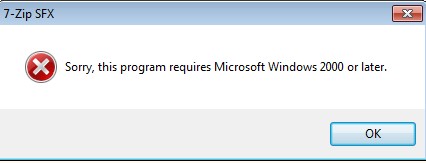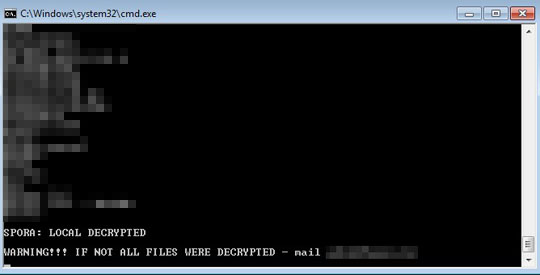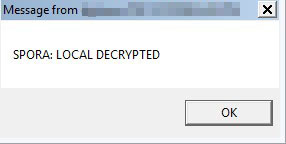RANSOM_FILECRYPTOR.R046C0DB618
Ransom:Win32/FileCryptor (MICROSOFT), TR/FileCoder.gndyv (ANTIVIR), Win32/Filecoder.NJO trojan (NOD32)
Windows


Threat Type: Ransomware
Destructiveness: No
Encrypted: No
In the wild: Yes
OVERVIEW
Downloaded from the Internet, Dropped by other malware
This Ransomware arrives on a system as a file dropped by other malware or as a file downloaded unknowingly by users when visiting malicious sites.
It encrypts files with specific file extensions. It encrypts files found in specific folders.
TECHNICAL DETAILS
96,814 bytes
EXE
No
06 Feb 2018
Drops files, Deletes files, Displays windows
Arrival Details
This Ransomware arrives on a system as a file dropped by other malware or as a file downloaded unknowingly by users when visiting malicious sites.
Installation
This Ransomware drops the following component file(s):
- {malware file path}\8F185AD69BC908.key
It drops and executes the following files:
- {malware file path}\8F185AD69BC908.cmd - is a batch file which searches for particular file extensions and launches 8F185AD69BC908.exe which performs encryption on the found files.
- {malware file path}\8F185AD69BC908.exe - contains the encryption routine
Other System Modifications
This Ransomware deletes the following files:
- {malware file path}\8F185AD69BC908.cmd
- {malware file path}\8F185AD69BC908.exe
- {malware file path}\8F185AD69BC908.key
Other Details
This Ransomware drops the following file(s)/component(s):
- %Application Data%\{volume serial number}
(Note: %Application Data% is the Application Data folder, where it usually is C:\Documents and Settings\{user name}\Application Data on Windows 2000, Windows Server 2003, and Windows XP (32- and 64-bit); C:\Users\{user name}\AppData\Roaming on Windows Vista (32- and 64-bit), Windows 7 (32- and 64-bit), Windows 8 (32- and 64-bit), Windows 8.1 (32- and 64-bit), Windows Server 2008, and Windows Server 2012.)
It does the following:
- If the malware is run on a Windows operating system version lower than Windows 2000, it displays the following message box and exits:

- It executes the following commands:
- ping -n 30 127.0.0.1
- msg "%USERNAME%" "SPORA: LOCAL DECRYPTED"
- 8F185AD69BC908.exe /key 8F185AD69BC908.key /file "%%~fd"
- After it gathers files and the encryption routine is performed on those files, it displays the following windows:


Ransomware Routine
This Ransomware encrypts files with the following extensions:
- .docxml
- .dot
- .doc
- .docx
- .docm
- .xls
- .xlsx
- .xlsm
- .xlsb
- .xltx
- .xltm
- .xlam
- .odt
- .rtf
- .bpdx
- .msg
- .pptx
- .pptm
- .potx
- .potm
- .ppsx
- .ppsm
- .psd
- .dwg
- .cdr
- .jpg
- .jpeg
- .tiff
- .wmv
- .mp4
- .avi
- .bmp
- .cd
- .1cd
- .dbf
- .sqlite
- .dt
- .cf
- .cfu
- .epf
- .log
- .lgf
- .lgp
- .elf
- .cdn
- .efd
- .geo
- .gsf
- .zip
- .rar
- .7z
- .backup
- .tib
- .bak
- .bak1
- .bak2
- .bak3
- .bak4
- .002
- .003
- .004
- .005
- .006
- .007
- .008
- .009
- .010
- .wbk
- .ful
- .wbcat
- .backupdb
- .pdb
- .mdb
- .accdb
- .ace
- .arj
- .tar
- .cab
- .cfg
- .dxf
- .dwf
- .vbox
- .vdi
- .vhd
- .vhdx
- .vmdk
- .vmsd
- .vmx
- .vmxf
- .vob
- .pfx
- .cer
- .key
- .lic
- .sql
- .sql1
- .sql2
- .db3
- .dbs
- .frm
- .ldf
- .sdb
- .tmd
- .sdf
- .iso
- .mdf
- .mds
- .bin
- .nrg
- .cue
It encrypts files found in the following folders:
- {malware directory and its subdirectories}
NOTES:
Though it is able to gather files for encryption, it is not able to encrypt files due to some errors on its encryption routine.
SOLUTION
9.850
13.950.21
06 Feb 2018
13.951.00
07 Feb 2018
Step 1
Before doing any scans, Windows XP, Windows Vista, and Windows 7 users must disable System Restore to allow full scanning of their computers.
Step 2
Note that not all files, folders, and registry keys and entries are installed on your computer during this malware's/spyware's/grayware's execution. This may be due to incomplete installation or other operating system conditions. If you do not find the same files/folders/registry information, please proceed to the next step.
Step 3
Search and delete this file
- %Application Data%\{volume serial number}
Step 4
Scan your computer with your Trend Micro product to delete files detected as RANSOM_FILECRYPTOR.R046C0DB618. If the detected files have already been cleaned, deleted, or quarantined by your Trend Micro product, no further step is required. You may opt to simply delete the quarantined files. Please check the following Trend Micro Support pages for more information:
Step 5
Restore encrypted files from backup.
Did this description help? Tell us how we did.
